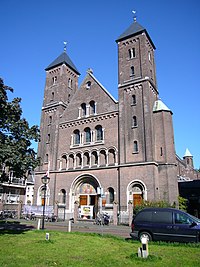Old Roman Catholic
| Old Catholic Church | |
|---|---|

|
|
| Classification | Independent Catholic |
| Orientation | Old Catholic |
| Theology | Ultrajectine |
| Polity | Episcopal |
| Archbishop |
Joris Vercammen, Metropolitan of Utrecht |
| Headquarters | St. Gertrude's Cathedral, Utrecht, Netherlands |
| Founder | Ignaz von Döllinger |
| Origin | 1870 Nuremberg, Kingdom of Bavaria |
| Separated from | Catholic Church (1879) |
The term Old Catholic Church was originally used from the 1850s by groups which had separated from the Roman Catholic Church over certain doctrines, primarily concerned with papal authority. These churches are not in full communion with the Roman Catholic Church. Member churches of the Union of Utrecht of the Old Catholic Churches (UU) are in full communion with the Anglican Communion, and some are members of the World Council of Churches.
The formation of the Old Catholic communion of Germans, Austrians and Swiss began in 1870 at a public meeting held in Nuremberg under the leadership of Ignaz von Döllinger, following the First Vatican Council. Four years later episcopal succession was established with the consecration of an Old Catholic German bishop by a prelate of the Church of Utrecht. In line with the "Declaration of Utrecht" of 1889, they accept the first seven ecumenical councils and doctrine formulated before East–West Schism 1054, but reject communion with the pope and a number of other Catholic doctrines and practices. The Oxford Dictionary of the Christian Church notes that since 1925 they have recognized Anglican ordinations, that they have had full communion with the Church of England since 1932 and have taken part in the ordination of Anglican bishops. Some orders are still recognized by the Roman Catholic Church although not any female priests.
The term "Old Catholic" was first used in 1853 to describe the members of the See of Utrecht who did not recognize any infallible papal authority. Later Catholics who disagreed with the Roman Catholic dogma of papal infallibility as defined by the First Vatican Council (1870) had no bishop and joined with Utrecht to form the UU. These Old Catholic churches today are found substantially in Germany, Switzerland, the Netherlands, and Austria. Union of Utrecht Old Catholic churches are not generally found outside of Western Europe.
...
Wikipedia
